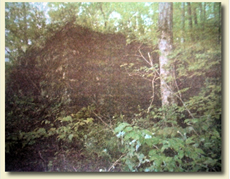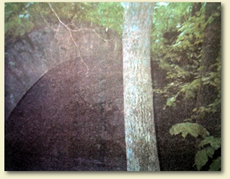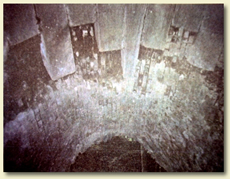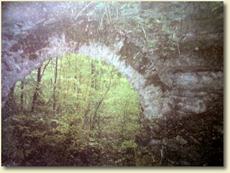The
site of the Empire State Iron Works is located a few miles
south of Trenton between Highway 11 and Lookout Creek. This
area appears on the Trenton, GA/AL quadrangle (101-SE) of
the U.S. Geological Survey maps.

Furnace base at Empire State Iron Works.
HISTORICAL
SIGNIFICANCE
It has been said that Dade County is the only area in Georgia
with sufficient iron and coal deposits to sustain a full
scale iron industry. As early as 1840 Benjamin Hawkins established
a bloomary forge about four miles south of Trenton, and
produced some iron on the site. This facility was abandoned
in 1851 and described as being in ruins by J. P. Lesley
in his Iron Makers Guide, published in 1859.
James A. Nisbet, the father of Colonel James Cooper Nisbet,
wrote on October 3, 1862 in the Macon Daily Telegraph, that
parties were coming to Dade County to engage in the "manufacture
of iron on a noble scale. Lowe & Co., who are refugees from
St. Louis and New Orleans, are organizing their operations
and are backed by strong Capitalists of the latter City."
These individuals selected a site near the old Hawkins Forge
and later that year, or in 1863, work began on the Empire
State Iron Works.
This
facility, operating under contract with the Confederate
Government, was in the final stages of construction when
the Federal Army of the Cumberland occupied Dade County
in September 1863. On September 5th General Negley sent
out reconnaissance patrols to investigate the area. One
of the groups found the Empire State Iron Works. The workers
had abandoned the site and fled to the mountain, but the
soldiers did take a number of items. General Negley sent
the following report to Corps headquarters: "An officer
just returned from the party sent out to reconnoiter in
the direction of Johnson's Crook reports the capture of
the following articles, viz: Large lot of spades, picks,
and shovels, 29 pairs of shoes, 146 sacks shelled corn (2
bushels), 13 sacks oats, 6 kegs nails, 1 keg fuse, 2 kegs
white lead, 250 sacks wheat, lot of stationary, 1 keg blasting
powder, 39 sacks salt (22 sacks since used and destroyed
by Thirty-ninth Indiana Mounted Infantry, 1 sack cotton,
1 barrel tar, 3 barrels lard." He later reported the capture
of additional items from the iron works: "between 200 and
300 bushels wheat, 35 sacks shelled corn, 16 sacks oats,
6 bushels onions, 20 head of cattle -- the property of the
Empire Iron-Works."General Rosecrans was in a hurry to get
his army over Lookout Mountain to confront the Confederates,
and the iron works were left intact when his forces departed
Lookout Valley. The site came to the attention of Federal
forces again two months later.
|

Furnace entrance at Empire State Iron Works.
When
General William T. Sherman was bringing his Army of the
Tennessee to relieve the siege of Chattanooga in November
1863, he wanted, in so far as possible, to deceive the
Confederates as to his true route and purpose. To this
end he sent his brother in law, General Hugh Ewing, with
a division, to invade Dade County from Bridgeport. Ewing's
instructions were to light numerous fires and create such
a disturbance that the Confederates would think that Sherman
was bringing his entire army in that direction with the
intention of striking the Confederates by moving up Lookout
Mountain and Rosecrans had earlier done. In the meantime,
while the Confederates were thus distracted, he would
bring the army directly to Brown's Ferry by way of Whiteside.

View from inside the furnace at Empire State Iron Works.
General Ewing carried out his instructions well and on November
20, 1863 reported to Sherman from Trenton, saying: "Loomis
camped 5 miles above Trenton at the iron works I am destroying
the iron-works, and hope by morning to see them all fall
to lawless ruin." The same day, Ewing ordered Captain Cassell,
Division Engineer, to begin the work of destroying the iron
works: "You will proceed at once to destroy the machinery
and stacks of all iron-works in Lookout Valley, using fire,
or powder. Make the work thorough, also destroy all tanneries
and machinery of mills attached to the iron-works." He issued
similar instructions to General Course who was camped near
the Empire Iron Works. "Set parties at once to undermine
and destroy the stacks and machinery of all iron-works in
your vicinity, but do not burn or blow them up -- do it
without noise. Cassell is coming with tools, but do what
you can."
|
In
his final report on his action in Dade County, Ewing stated:
"While in the valley we destroyed the iron-works, breaking
to pieces the engines and machinery and leveling the stacks
to the ground." In spite of this claim, visits to the iron
works sites in 2001 demonstrated that the destruction was
much less than complete and in fact remains of both furnaces
are still present.
The property is owned by Mr. Bobby Ryan of
Trenton.

Second view from inside the furnace at Empire State Iron
Works.
References: Official
Records of the War of the Rebellion
Archive and files Chickamauga and Chattanooga National Military
Park Raymond Evans, The Civil War in Dade County
Significant Views:
The owner of the property has stated firmly that he wishes
to keep his property out of any public use activity. It was
not visited during the present project out of respect for
his wishes. All the above information was gained from archival
sources or from interviews with former land owners.
Setting: The furnace
site is in an undeveloped wooded area between Highway 11 and
Lookout Creek.
Documented Structures,
Sites and Features: The focal point of the site was the
large limestone furnace built for the manufacture of iron.
There is a small amount of slag on the property that shows
that some iron was made before the Federal army captured the
site.
Presumed Wartime Features:
In addition to the furnace there would have been casting sheds,
storage buildings, and living quarters for the workers on
the property. There were several brigade size campsites here
in September 1863. Relic collectors have amassed a considerable
quantity of Federal material from these camps.
Original Terrain:
The terrain is wooded and apparently still largely rural and
retains much of its wartime appearance
Related Sites: Payne's
mill and the Macon Iron Works |